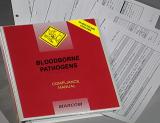Bloodborne Pathogens Safety and Needlestick Prevention
Bloodborne pathogens: what are they?
Bloodborne pathogens are contagious bacteria that can make people sick when they are present in human blood. These pathogens include the human immunodeficiency virus (HIV), hepatitis B (HBV), and hepatitis C (HCV) (HIV). Worker exposure to bloodborne infections may result from injuries caused by needlesticks and other sharp objects. First responders, housekeepers in various sectors, nurses, and other healthcare workers are just a few of the numerous vocations that might expose their workers to bloodborne viruses.
What to do if you have a needle stuck in you:
If a needle or other sharp object pokes you, or if blood or other potentially infectious materials go into your eyes, nose, mouth, or damaged skin, flush the area with water right away. Then, treat any wounds with soap and water or, if one is available, a skin disinfectant. Contact your employer right away and get medical help right away.
How may exposure to bloodborne infections be controlled?
An employer must establish an exposure control strategy for the workplace with specifics on employee safety measures to lessen or eliminate the risks of occupational exposure to bloodborne pathogens. In accordance with OSHA's Bloodborne Pathogens Standard, the plan must also include how an employer would apply to engineer and work practice controls, personal protective gear, training, medical monitoring, hepatitis B vaccines, and other requirements (29 CFR 1910.1030). Engineering measures, such as using safer medical equipment, including needleless devices, shielded needle devices, and plastic capillary tubes, are the main way to prevent or minimize staff exposure.
Requirements for training:
Employers must educate and train employees in accordance with OSHA's Bloodborne Pathogens Standard (29 CFR 1910.1030). Employers are required to see to it that all aspects of the standard, including but not limited to: knowledge of bloodborne pathogens and illnesses, controls for occupational exposure, hepatitis B vaccinations, and medical evaluation, including post-exposure follow-up procedures, are covered in the regular training that employees receive. The first time a worker is assigned, at least once a year after that, and whenever new or altered activities or processes influence a worker's risk of occupational exposure, employers are required to provide this training.

Bloodborne Pathogens in Healthcare Facilities Safety Video

Bloodborne Pathogens in Healthcare Facilities - Compliance Manual
The Bloodborne Pathogens in Healthcare Facilities manual review the regulations and their compliance requirements, as well as provide materials that are necessary to help meet those requirements.




